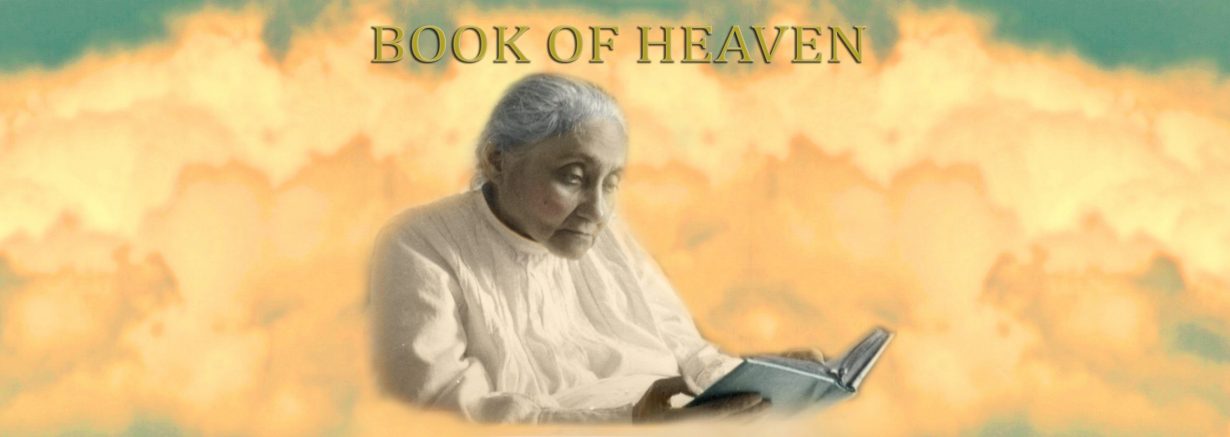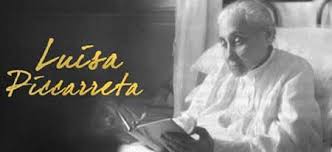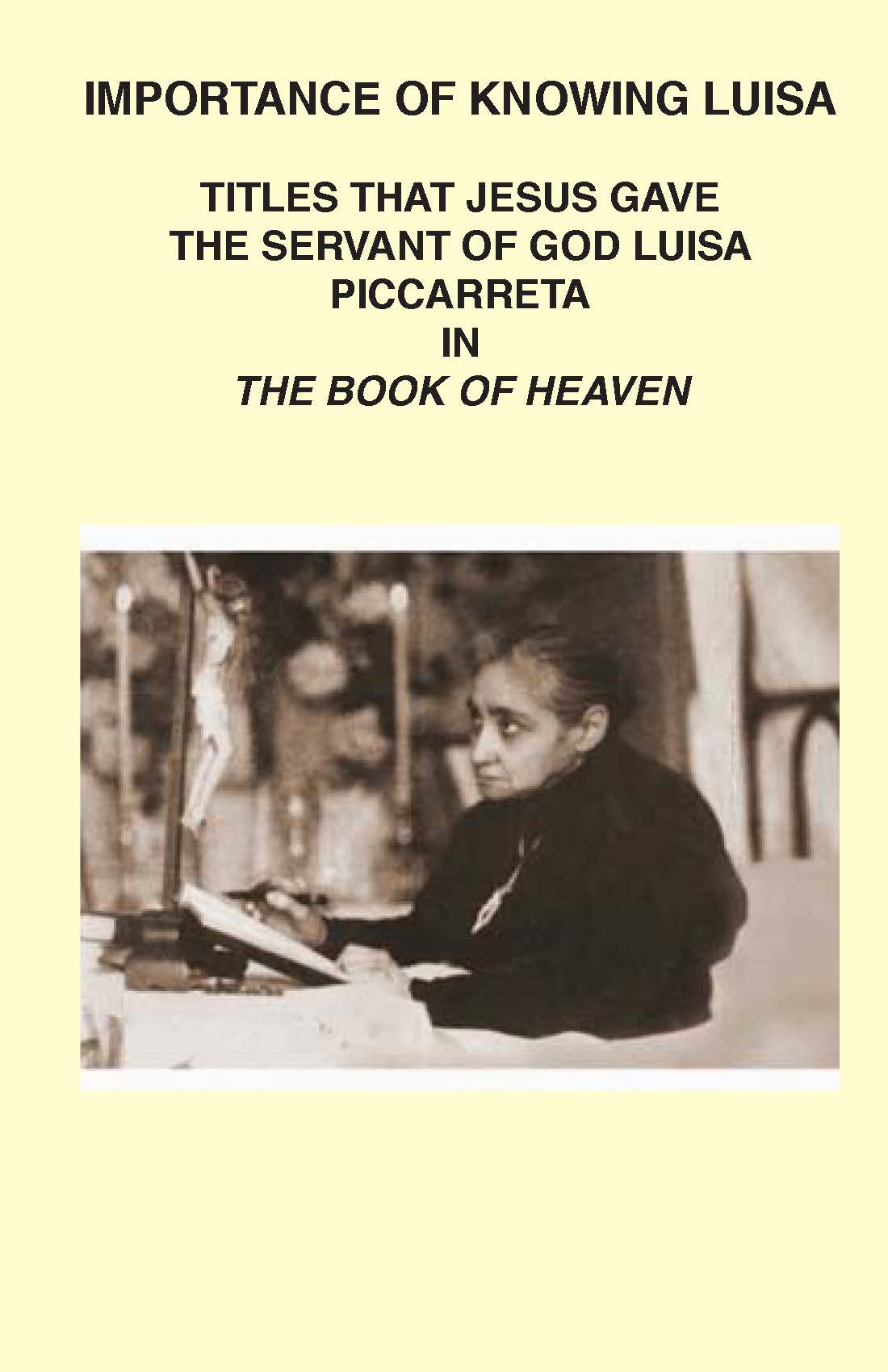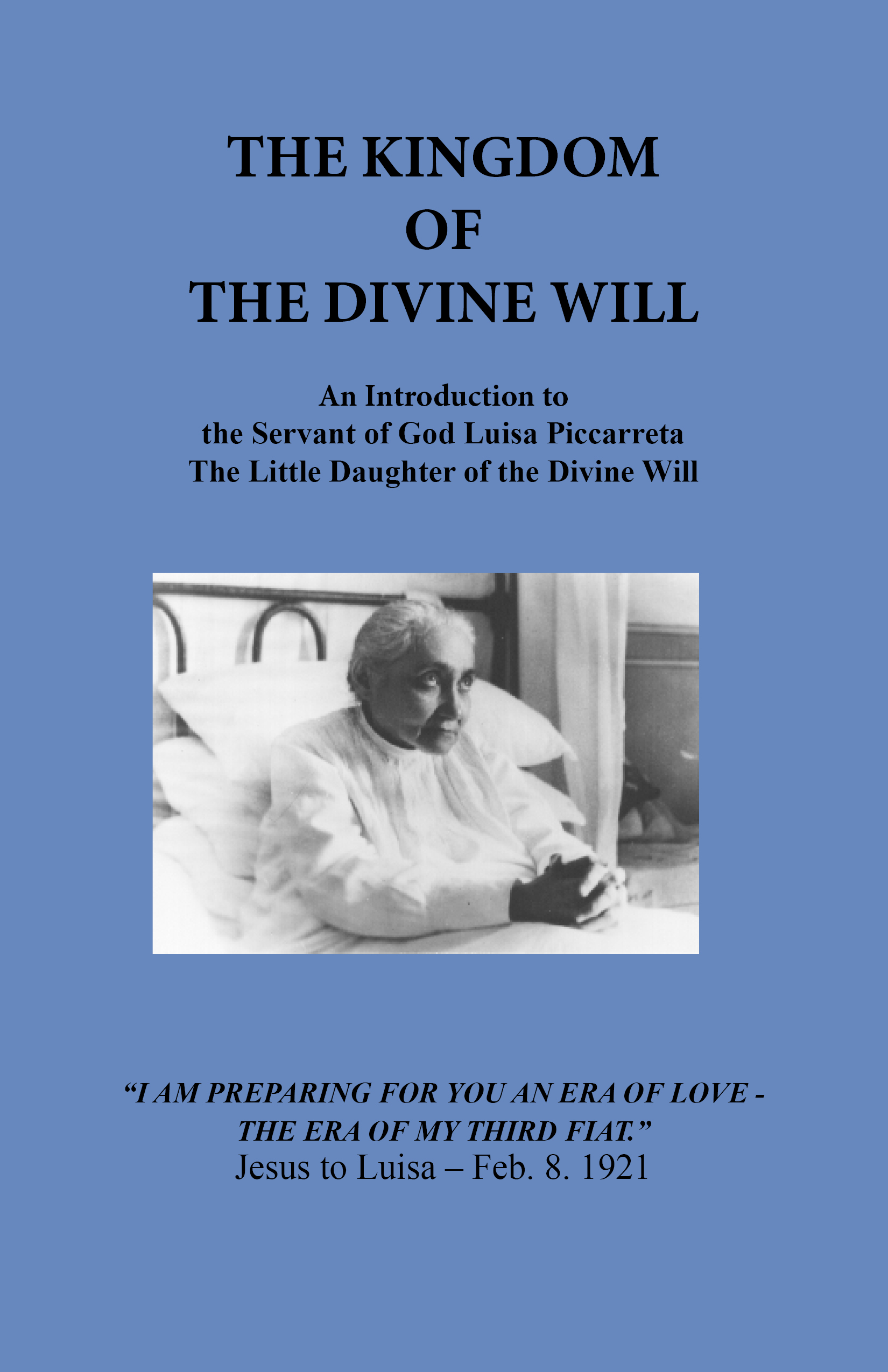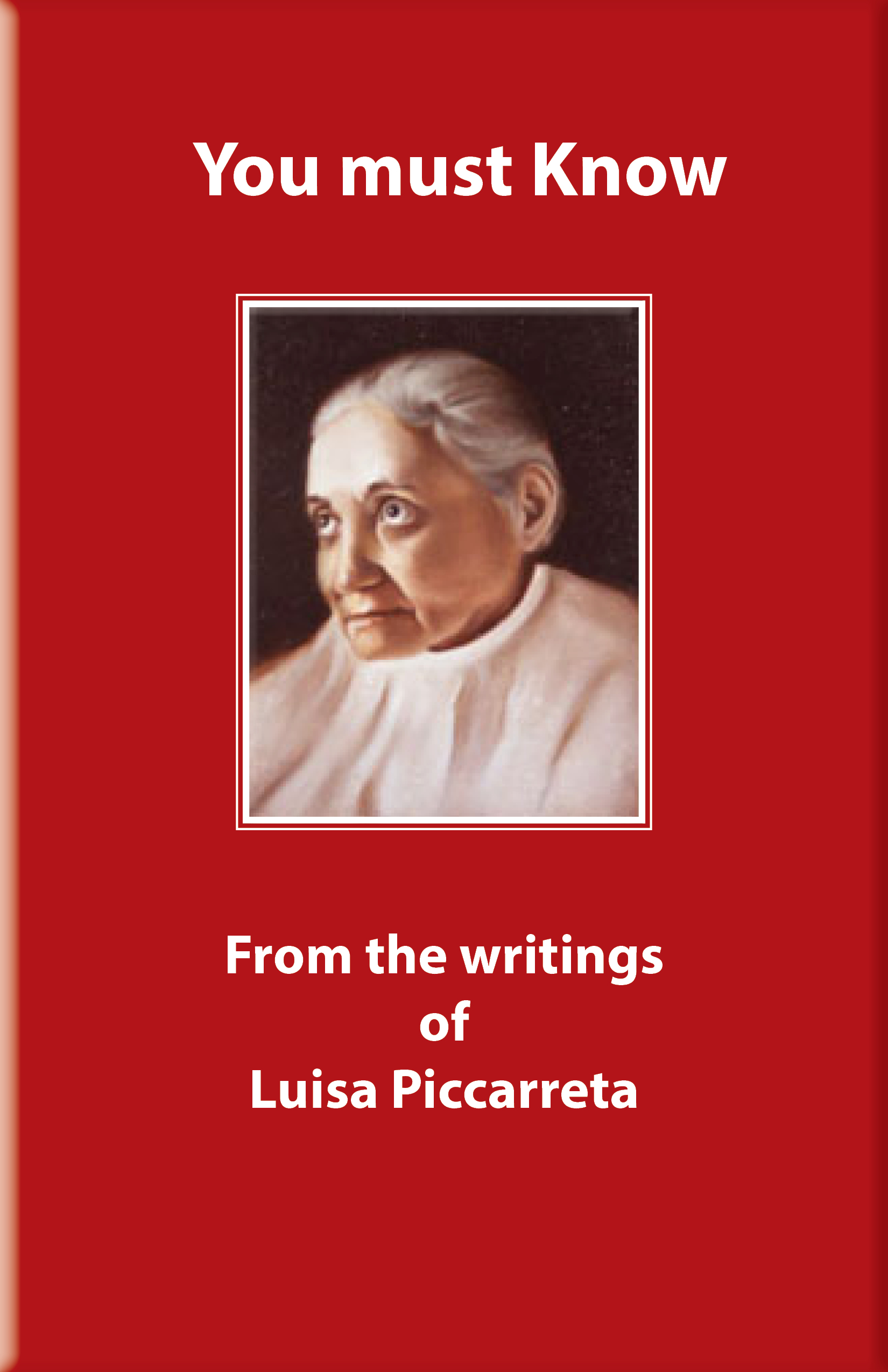From: http://aronbengilad.blogspot.com/2020/12/jewish-ancestry-of-luisa-piccarreta.html
The servant of God Luisa Piccarreta was an Italian Catholic mystic. Luisa is the most important saint after the Incarnational Circle or Order of the Hypostatic Union of Jesus, Mary and Joseph. She is the prophesied “little woman” expected by the Jewish mystics. She is the mystical “face over all the earth” in Genesis 1 and the fourth light which is the lesser or little light (moon), when we read Genesis at the mystical levels (allegorical and anagogical called in Hebrew Remez and Sod). This “very little one” is the Daughter of Edom (Roman Catholic Church) but at the same time she is of hidden Jewish ancestry and a descendant of Rebbe Nachman of Breslov. The female descendants of Rebbe Nachman became lost among the Gentiles and in a sense Luisa acts as a Shabbas Goy to the Temple of the Heart of Jesus, Mary and Joseph. She was mystically and really present with them in the Holy House of Nazareth, in a manner we don’t fully comprehend. In a sense all those who live in the Divine Will were/are also present in the Holy House in, with and through Luisa.
I wrote about this in my essay “Eizeh Tikkun! Rebbe Nachman and Reparation”:
Rebbe Nachman’s father Rabbi Simcha Horodenker married Feige the granddaughter of the Baal Shem Tov who was considered a Tzaddika (a female Tzaddik) of great stature like her mother Udel or Adel the daughter of the Baal Shem Tov. Rebbe Nachman also prized his own daughters and their spiritual gifts and commanded his followers to “ Be careful with my offspring, make sure that they stay within the Hasidic movement.” Rebbe Nachman once said: “My daughters have ru’ach hakodesh (holy spirit), which is close to prophesy. And I’m not talking about Sarah at all!” Rebbe Nachman taught his followers that they must always honour and respect his daughters as they were “precious trees that would give forth rare and goodly fruits.” In recent decades the Breslov Hasidim have mounted a mission called Operation Breslov to find and return the halachically Jewish descendants of the daughters of Rebbe Nachman, who are now living among the Gentiles.
Luisa was descended from a network of Hasidic families and/or individuals who after the death of Rebbe Nachman of Breslov in 1810 embraced the Catholic Faith. Some of them joined the other groups of Jews who had embraced Catholicism after 1760 who were known as the Frankists or Zoharists. These were the groups that opposed secretly Eva Frank and her group of Frankists which had reverted to many Sabbatean teachings. We can call this group or network that was opposed to Eva Frank and her Prague Sabbatians the Papal Frankists or Zoharists. These post-1810 Papal Frankists were eventually led by Moshe ben Zalman the son of the Alter Rebbe of Lubavitch in secret and unlike the other group of Papal Frankists they were more into “littleness” and simplicity rather than the baroque style of Jacob Frank and his followers. Thus we can say there were at least four distinct groups of Frankists or Zoharists. They were the Sabbatean Frankists (following Eva Frank the daughter of Jacob Frank from his second wife), the Baroque Papal Frankists (following Jacob Frank and his daughters by his first wife), the Simple Papal Frankists (following Rav Moshe ben Zalman the Catholic son of the Alter Rebbe of Chabad and the Catholic descendants of Rebbe Nachman of Breslov) and the Hasidic Frankists (followers of Rebbe Nachman who remained in the Hasidic Jewish Community).
The parents of Rebbe Nachman were secret followers of the teachings of Jacob Frank. In 1781 they arranged a marriage between their daughter Reizel Hordenker (Rosa) and one of the tall handsome young guards of Frank who was an Italian Jew called Giuseppe Francavilla whose mother was a Jewish Frankist. He was the illegitimate son of Vincenzo Maria Imperiali (1738-1816) the Prince of Francavilla who was a knight, scholar, writer and poet. Giuseppe (Joseph)’s mother Rachel Frankovitch Ricchi a niece of Jacob Frank used the name Signora Francavilla. He was named Joseph by his mother in honour of Jacob Frank who had taken the name Joseph at his baptism. After the marriage of Giuseppe and Rosa they settled in Foggia in Italy. After 1760 some Frankists had settled in the area of Foggia which had a population who were descended from crypto-Apulian Jews who had become sheep farmers.
Rosa Francavilla’s brother Israel der Toiter Horodenker (who was also a Frankist) would also join his sister with his wife in Foggia sometime before 1800 where he took the name Francesco Tarantino (1776-1850). Two other brothers of Rosa, who were twins, moved to the Boot of Italy some time after the death of Rebbe Nachman in 1810. They would settle further south of Foggia at Corato and they took the name Piccarreta (which means “very little one”). Vidal Chaim Horodenker (1780-1850) took the name Vito Piccarreta and Elkanah haKatanah Horodenker took the name of Francesco Saveria Piccarreta (born 1780). Corato may have also been an area where Crypto-Jewish Apulians had settled.
Rosa Francavilla’s daughter Girolama (Yael Shoshana) Francavilla was born in Foggia in 1782 and she married Scottish -born Giuseppe (Joseph) Russo a great-grandson of Jacob Frank. Another daughter of Rosa called Maria Luigia (Miriam Lea) Francavilla who was born in Foggia in 1785 married Michele Fiumedinisi (Moshe Fundminsky) who returned to Judaism and left Italy for the Russian Empire. Girolama named her daughter Maria Luigia (Luisa) Russo (born 1810 Foggia) after her sister. Maria Luigia Russo had siblings called Michele Alfonso (b.1799) who married Maria Saveria Antonia Fascele, Eugenia (b.1801) who married Vincenzo Russo and Giacinto (b.1808) who married Anna D’Onofrio. Maria Luigia Russo married her cousin Antonio Raffelle Tarantino (b.1801 Foggia). They moved to Candela a town south of Foggia. They were the parents of Rosa Tarantino (b.1830 Candela) who was the mother of the servant of God Luisa Piccarreta. Luisa Piccarreta had four sisters Philomena, Angela, Rachele and Maria.
Luisa’s mother married her relative Vito Nikola (Nathan Chayim) Piccaretta of Corato (born 1825 in Corato) the son of Vito Piccarreta (Elkanah Horodenker) of Corato. Vito Piccareta married Margherita Pedone (aka Margolis Aurebach) a daughter of Rabbi Yoska Aurebach and Udil (Della) Horodenker a daughter of Rebbe Nachman of Breslov. Elkanah married Margolis around 1818 in Russia before Margolis’ parents moved to Ireland. Margolis parents settled in Ireland where they used the names Joseph and Della O’Brien. Her father died in Ireland around 1830 but her mother returned to Russia and open Judaism and married her widowed brother-in-law Rabbi Isaac Dubrovner the husband of her sister Sarah Horodenker.
In my essay entitled ” Eizeh Tikkun! Rebbe Nachman and Reparation” I wrote about this mystical little woman:
The Baal Shem Tov, Jacob Frank and Rebbe Nachman’s focus and respect on their daughters, may have partly been because they perceived in the traditions that a little woman was to come in the future, who would receive the grace to live in this perfect littleness in the Divine Will in a permanent way on earth. Likutey Moharan I:49:5 the Rebbe teaches:
“This is the aspect of the song that will awaken in the future. It is a simple-twofold-threefold-fourfold song, this being the Ten Kinds of Song…If your wife is short, bend down and l’chish (listen) (Bava metzia 59a). Rashi comments: listen to her counsel. In fact a godfearing woman is the aspect of advice. When the prayer- that is the aspect of David’s kingdom- is lowly [shiflut] and KaTNut [constricted /smallness]- in the aspect of “your wife is short” and “we have a ktaNa [little] sister (Song of Songs 8:8]- it corresponds to “the KaTaN (lesser) light” (Genesis 1:16), in the aspect of “his counsel falls away” (Sanhedrin 22 a)…For in the future, in the Era that is entirely Shabbat, the Torah of the Hidden Ancient One will be Revealed…this is also the aspect of ‘Great is Repentance”. He elevates repentance (teshuva) from the aspect of the lesser light, from the aspect of “we have a little sister”, to the aspect of the big, to the aspect of “the light of the moon will be like the light of the sun” [Isaiah 30:26]…”
Thus, in the style of the Rabbis of the Zohar, Rebbe Nachman, weaves a series of scriptural texts and other Jewish sources into a cryptic text that can be understood with different meanings but only truly understood when read in a messianic light and a deep knowledge of the Zohar and the other texts of Judaism. This small passage for the mystical adept alludes to the Song of Miriam at the Red Sea, which is linked to Miriam as the little sister of Moses who watched over him by the river and who in Jewish mystical tradition is associated with the mystical light of the moon. Then with the use of Genesis 1:16 linked with Song 8:8 and a Talmudic passage he further develops this idea of the little woman, who like a new Miriam, will lead us to when the light of the moon becomes like the light of the sun in the era of the messianic Sabbath.
This light of the mystical sun is the light of the Divine Will and the light of the Messiah that was hidden away on the first day of creation. The passage in Malachi alludes to this Tzaddika when it states, “the Sun of righteousness (Tzedaka), shall arise with healing in his wings.” Jewish spirituality began to stress that this potential Tzaddika, who embodies the Shekhinah on earth, can be shared or appropriated by all woman and thus a husband should see his wife as this embodiment of Shekhinah. In greeting and receiving the Sabbath Queen he is also receiving his wife. Each Jewish wife seated at her Sabbath table is a living icon of the Sabbath Queen seated on the Throne of Glory. This iconic imagery is also linked to the Jewish Queen-Mother (G’birah) enthroned beside her anointed son the King. Likutey Moharan 49 is headed by the verses from Psalm 19: 5-8 that begins as Lashemesh Sam Ohel Bahem (He set up a tabernacle in their midst for the sun). In the Zohar and other Jewish mystical writings these verses are linked with the bridegroom of the Song of Songs and the Ark of the Covenant. These literary images or icons all give a hidden Eucharistic and Marian meaning to the texts.
This whole idea of the mystical sun and woman in Rebbe Nachman is already found in Jacob Frank in which he links the “Hind of the Morning” (ayelet ha-shachar) of Psalm 22:1 with the Virgin of Czestochowa. In this tradition the horns of the deer are seen as resembling the rays of the rising sun thus linking it to the Messianic and Eucharistic verses in Malachi about “the Sun of Righteousness rising” and the pure oblation offered “from the rising of the sun.” This is linked to the sun chariot psalm mentioned above, as well as others. The chanting or reciting of certain psalms will become central to Rebbe Nachman’s universal tikkun and he will propose the reciting of ten psalms as part of the ritual of tikkun. In a sense this is a Davidic tikkun as David the traditional author of the Psalms, committed grave moral sins and it was through his prayer and sorrow that he attained forgiveness. Like David, Rebbe Nachman lost a young son -Shlomo Ephraim- and he saw it in terms of it being a sacrifice and tikkun he had to pay for the sins of his generation.
In the near future at the height of the tribulation God will send a special teacher and prophet who will guide us in the dark days. This is predicted in both Jewish and Catholic prophecies. This will be a prophet of Divine Will who will proclaim the teachings given to Luisa Piccarreta. He may be a Jewish prophet with the charism and power of both Elijah the Prophet and Moses our Teacher and will be a descendant of Rebbe Nachman of Breslov, Rav Nathan of Nemirov and the Alter Rebbe of Chabad. He will be a new Nathan the Prophet who will be associated with the new Davidic Monarch (the Catholic Great Monarch) and the new Zadok the Priest (the Angelic Pope). While I am a descendant of the three mentioned above I want to make it clear I am not referring to myself. But like John the Baptist I am a Voice pointing to and praying for this future Great Prophet of God, in my own little way.
Blessed Father Francisco Palau of Spain (1811-1872) was a Spanish Discalced Carmelite friar. He created the “School of Virtue”—a mode of catechetical teaching in Barcelona. He taught:
From one moment to another there will appear a Moses, a man whom hell, the Heavens, the Elements, and all of Nature will obey. The wonders with which the Divinity of His Mission will be accredited will be so stupendous, that those which Moses realized before the King of Egypt are nothing but a shadow and figure. At His orders the seas will rise from the deep and drown entire cities: the Earth will be covered in darkness so dense that not even the objects most near will be seen as shadows. At His voice fire will descend, sulfur from Heaven, and the Earth will open and hell will swallow alive the modern sacrileges Dathan, Core, Abiron, (Num 16) and those who contest His Mission. Under the direction of this Man, the entire Orb will fight against the foolish ones.
The chosen, only the chosen, will follow this restorer, those who have their name written in the Book of Life, and the rest of the Catholics will apostatize dividing themselves one from the other. What is written about the Son of man will be fulfilled in the person of this RESTORER …He will be unknown, persecuted, despised by the Catholics whose names are not written in the Book of Life (…) Satan will be locked up in the abyss by the new Moses and by His Apostles, and with him will be buried in hell the evil of the Earth(…), When will this RESTORER come? There is no other restorer known but Elijah Tesbites. “Elijah venturus est et eumvenerit, restituet omnia,” if true restoration is coming that consists in the conversion to the God of all Nations and of its kings, the RESTORER cannot be a king, but an Apostle; war does not convert but ruins, and this apostle will be Elijah, the promised Elijah, whatever the name He is given when He appears. Whether He call himself John, Moses, Peter, the name matters little: the mission of Elijah will restore human society, because God has it so ordered in His Providence.
Four of Rebbe Nachman’s daughters left descendants. These four daughters were Udil (Adel or Della) (b.1787), Sarah (b.1790) Miriam (b.1792) and Chaya (b.1801). Researchers have reported the difficulty of sorting out the genealogy of these daughters’ families. This is due to the Jewish practice of cutting out or listing as dead any one who converted to Christianity and the reinvention of their genealogy and family stories to fill these gaps and changes. To have such people in a devout Jewish family gave that family bad yichus and affected their marriage prospects. This was known among other Hasidic groups and many of them avoided intermarriage with the Chabad and Breslover Hasidim.
Rebbe Nachman may have had a son Jacob (Yankel) from his second wife who was born in Lvov in 1808 as claimed by some Jewish families who descend from Yankel Baron (Baron being an acroustic for Ben Rabbi Nachman according to them). Some of his descendants became Catholic others did not. Some descendants who were baptised later reverted back to Judaism. If this Yankel Baron was a hidden son of Rebbe Nachman then he married his niece Bracha (Brocho) Zaslavski a daughter of Chaya. This couple may have been baptised as children but they later reverted back to Judaism or at least joined the secret Frankists in the Jewish community rather than being part of the Gentile Catholic world. Rebbe Nachman belongs to R1b L21 L583 y-dna haplogroup a Jewish branch of the House of King David that went to Barcelona.
Sarah and Miriam were never baptised as far as I can work out. However some of Sarah’s descendants were and some did not. Miriam’s two children were and her family cut one from the family tree and the other was said to have died young. However Miriam’s children were not converted to Catholicism but to the Anglicanism of Joseph Wolff (who came from a Frankist family descended from Jacob Frank and was first a Catholic but later became an Anglican priest and famous missionary). It would seem that after the death of Rebbe Nachman both Udil and Chaya became Catholics as did many of their children. It was from Udil the eldest child and daughter of Rebbe Nachman that Luisa Piccarreta’s father descended through his mother who was a granddaughter of Rebbe Nachman.
Udil Horodenker (1787-1864) married in 1800 to Rabbi Yoska Aurebach (1785-1830) and they had at least eight children. They were Feige (b.1803 d.1827) who married Gershon Yehuda Leib Broide (Brody) (1804-1826), Margolis (b.1804) who married her uncle Elkanah Horodenker (b.1780), Shifra Rachel (b.1805 d.1882) who married Avrum Dov Chmelnitski, Sarah (b.1806 d.1901) who married Rabbi Moshe (Michael) Nemirov (BReNaN) (1795-1865), Chana (Honora) (b.1808 d.1891) she married Yehuda Flehinger (aka John Flanaghan) and Peter Murphy (Morpurgo), Rivka Miriam (1809 d.1843) who married her first cousin Rabbi Simcha Baruch Dubrovner (b.1808), Avraham Dov (b.1810 d.1880) and Miriam (Mary) (b.1813 d.1881) who married William Maher (1810-1868). Udil married in 1832 her brother-in-law Rabbi Isaac Dubrovner (d.1834) after the death of her first husband in 1830. As she was 44 when she married her second husband it is unlikely she had any children with him.
Sarah Horodenker (1790 -1832) married in 1803 to Rabbi Isaac Dubrovner (1787-1834) and they had at least four children. They were Ephraim (b.1804) who married and had at least three children Feige, Isaac and Nachman, Israel (b.1806) a Rabbi who married Chaya Sarah Rabin Twersky, Simcha Baruch (b.1808) who married his first cousin Rivka Miriam Aurebach (1809-1843) and Feige Sashia (b.1812) who married Rabbi Ephraim Veisz of Medzeboz (1803-1855).
Miriam Feige Horodenker (1792-1809) married in 1805 Rabbi Pinchas Segal. They lived in Jerusalem. They had two children Gershon (b.1805) who married and had at least one son called William George Pollard and Lea (b.1808 d.1850) who married Thomas Richard Williams (1803-1892).
Chaya Horodenker (1801-1843) and she was married twice. She firstly married Rabbi Zalman Lubarsky in 1814. They had one son Nachman Chayalas (b.1815 d.1889) a Rabbi who married Chana bat Dov Gottlieb of Karlin. She then in 1816 married Aharon Zaslavsky and they had at least five children. They were Bracha Rachel (b.1818) who married Jacob (Yankel) Baron, Miriam Chaya (b.1820) who married Nathan ben Moshe (aka Michael William Brennan) (1820-1875), Rachel (b.1722) who married her cousin Isaac Dubrovner (b.1820), Adil (Udil or Della) (b.1824) who married Avraham Sfarad (d.1870) and Yechiel (b.1826) who married Shterna Sashia Lubarsky.
He married Sashia (Alexandra) Broida (Ossatin) 1772-1807
/
Udil (Della) Horodenker aka Mrs Della O’Brien 1787-1864
She married Rabbi Yoska (Joseph) Auerbach (O’Brien) born 1785
/
Margolis Aurebach aka Margherita Pedone born 1804
She married Elkanah haKatanah Horodenker aka Francesco Saverio Piccarreta born 1780
/
Udel Simcha Bas Yisrael 1720-1787
